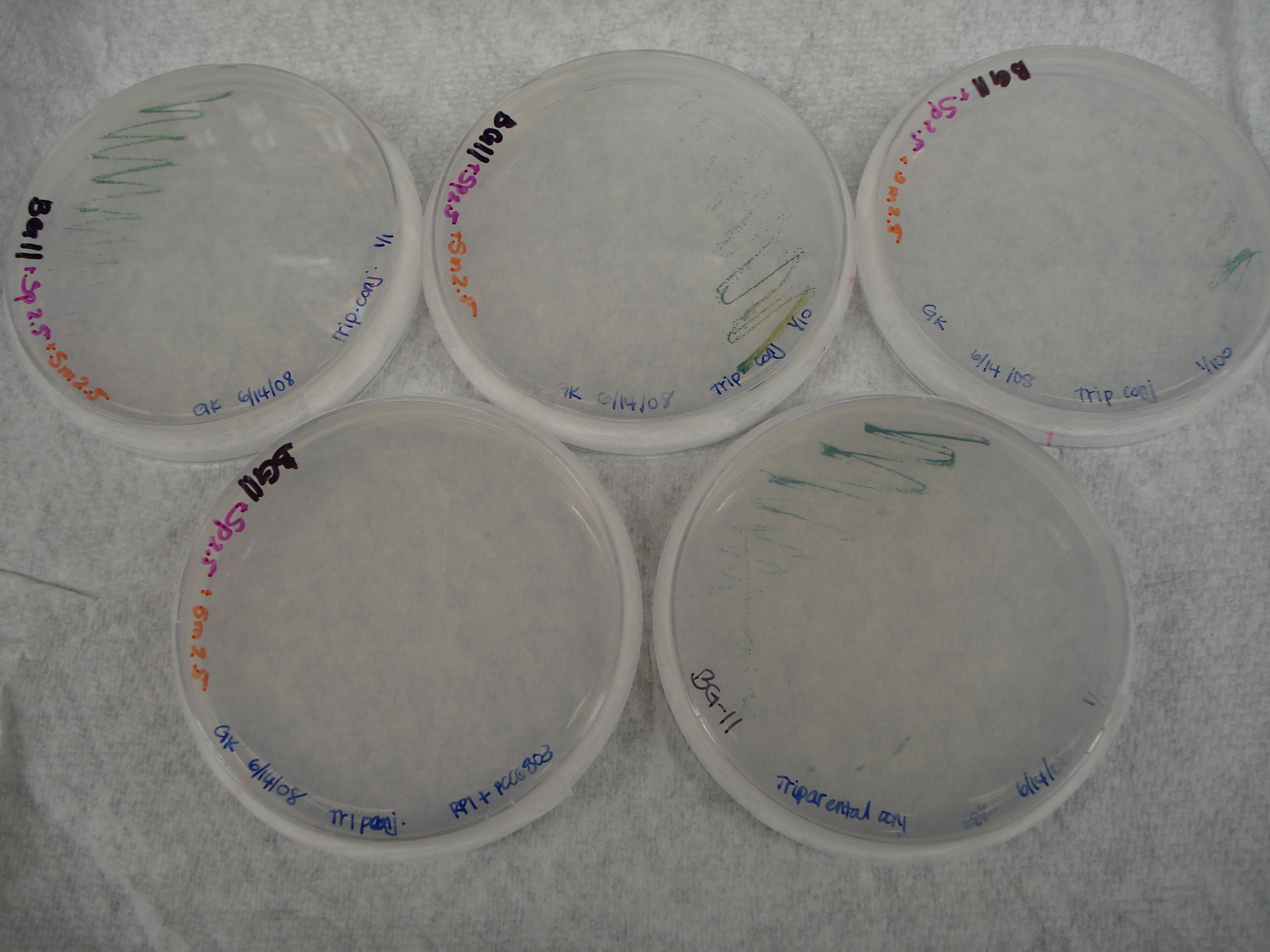Team:Hawaii/Tri-parental conjugation between E. coli and PCC6803
From 2008.igem.org
Contents |
Theory behind tri-parental matings
"Mobilization of a plasmid into a recipient cell is often used for cloning, transposon mutagenesis, or other procedures. As mentioned, mobilizable plasmids have an advantage over self-transmissible plasmids in being smaller. Nevertheless, difficulties can be encountered before these plasmids can be mobilized. For example, the self-transmissible plasmid and the plasmid to be mobilized may be members of the same Inc group and so do not stbaly coexist in the same cell. Also, the self-transmissible plasmid may express its tra genes only for a short time after entering a recipient cell so that transfer is inefficient.
"Triparental matings help overcome some of the barriers to efficient plasmid mobilization. As the name implies, three bacterial strains participate in the mating mixture. The first strain contains a self-transmissible plasmid, the second contains the plasmid to be mobilized, and the third is the evenaul recipient. After the cells are mixed, some of the self-transmissible plasmids in the first strain are transferred into the strain carrying the plasmid to be mobilized. Becauase it is fertile when it first enters the cell, the self-transmissible plasmid quickly spreads through the population of cells containing the mobilizable plasmid. It is then able to mobilize the mobilizable plasmid into the third strain with a high efficiency because new transconjugants retain their ability to transfer for at least six generations. Contrast this to a mating involving only two strains, one of which contains both the self-transmissible plasmid and the mobilizable plasmid. Only a small fraction of the cells are fertile and can mobilize the mobilizable plasmid into the recipient strain. Also in a triparental amting, even if the two plasmids are members of the same Inc group, they coexist long enough for the mobilization to occur."
Reference:
Snyder, Larry and Wendy Champness. Molecular Genetics of Bacteria. 3rd ed. Washington: ASM Press, 2007. 259.
Protocol from Callahan Lab
- Based on Anabena experiments
- Grow cyanobacteria into exponential phase in liquid BG-11.
- Streak out fresh plates of transformed E. coli one day before. Use to innoculate 40 ml SOB and allow E. coli to grow until OD600=0.6.
- Pellet E. coli. Wash with 40 mL BG-11. Pellet and wash again.
- Resuspend pellet in 1.4 ml BG-11.
- Spot E. coli and cyanobacteria together on BG-11 + 5% LB plate. Use 5 μl of each E. coli strain and 10 μl of cyanobacteria.
- Wait for spot to dry on plate.
- Incubate for 2 days in light and CO2 at 30C.
- Use a loop to scrape the growth on the BG-11 + 5% LB plate.
- Streak innoculate on BG-11+sp+sm.
- Incubate in light and CO2 at 30C.
Note: Because E. coli may curtail the growth of cyanobacteria (sometimes even killing them), it is suggested that 1/1, 1/10, and 1/100 dilutions of E. coli cultures be made before spoting with cyanobacteria.
Results
Notes: We had to incubate the BG-11 + 5% LB plates w/o CO2 for 14 hours because the Callahan lab was closed last night. Plates were brought over to the CO2 incubator this morning.
Triparental conjugation is a SUCCESSFUL method of introducing foreign DNA into PCC6803. Nine days after plating on BG-11+sp+sm, PCC6803 growth was observed at 1/1, 1/10, and 1/100 dilutions of E. coli. No growth was observed for conjugation of PCC6803 with E. coli containing only RP1 (negative control). RP1 itself does not confer sm/sp resistance. Growth was observed for transformed PCC6803 plated on BG-11 (no antibiotics, positive control), showing that the mating process did not adversely affect PCC6803 to any significant degree.
Discussion
From beginning to end, triparental conjugation between E. coli and PCC6803 takes 14 days. Exploring other methods of transformation that would minimize this lag time would be extremely advantageous.
 "
"
